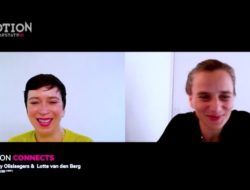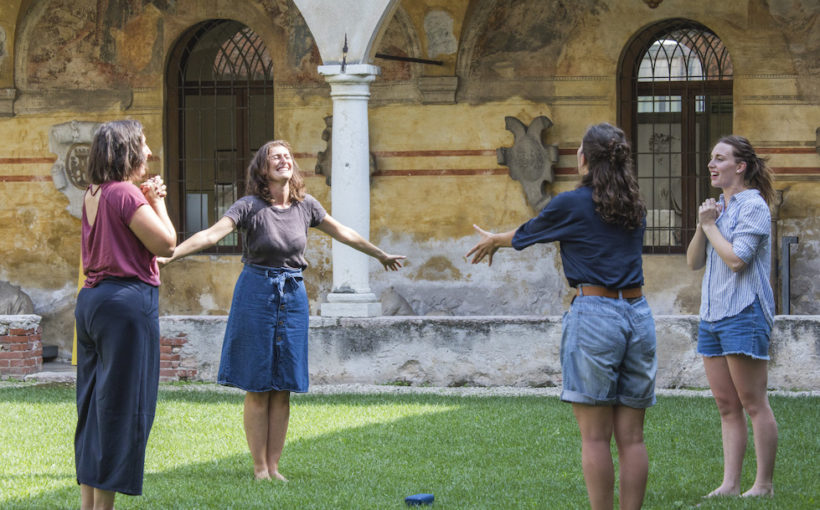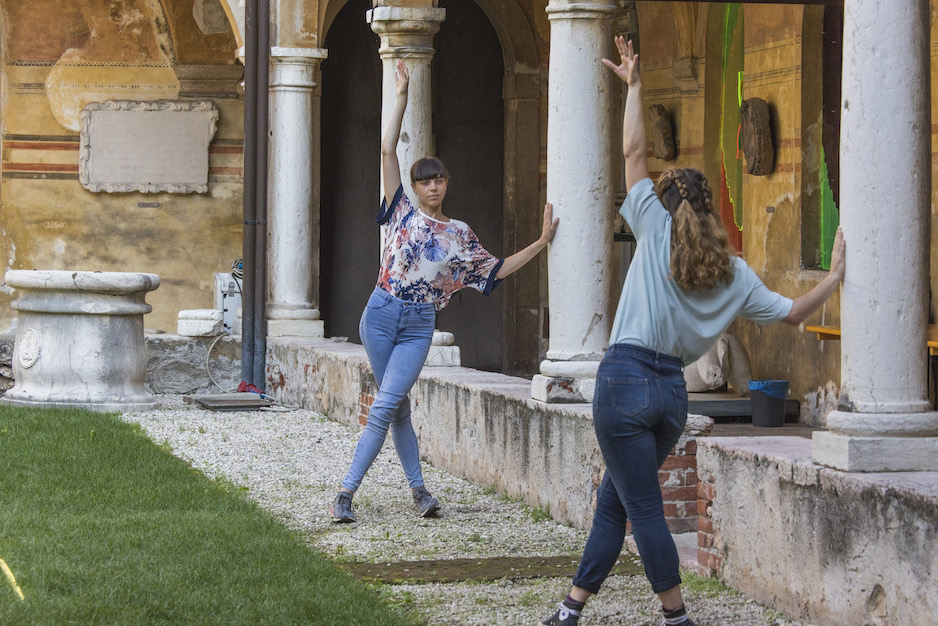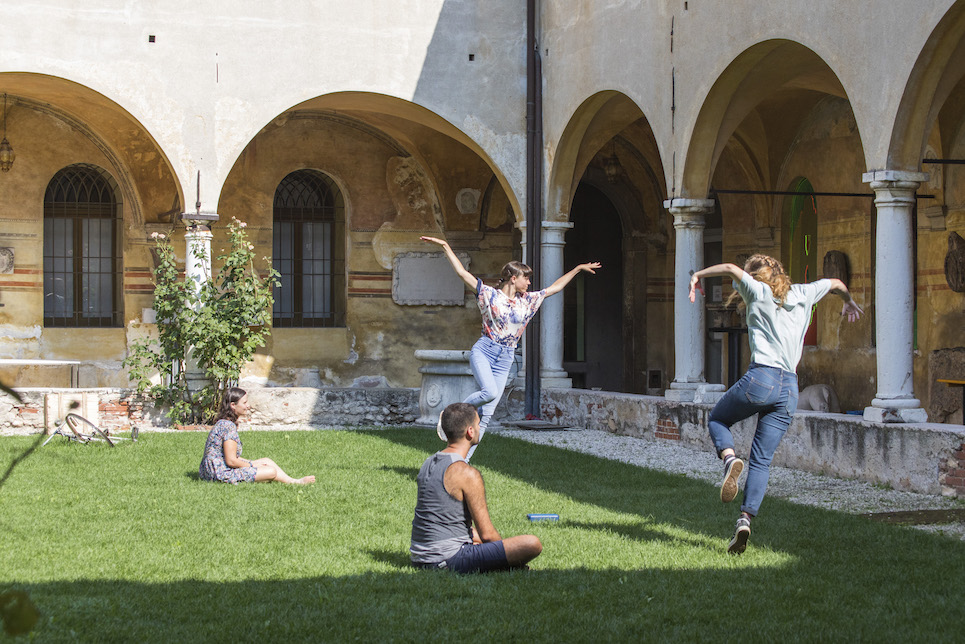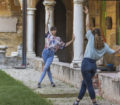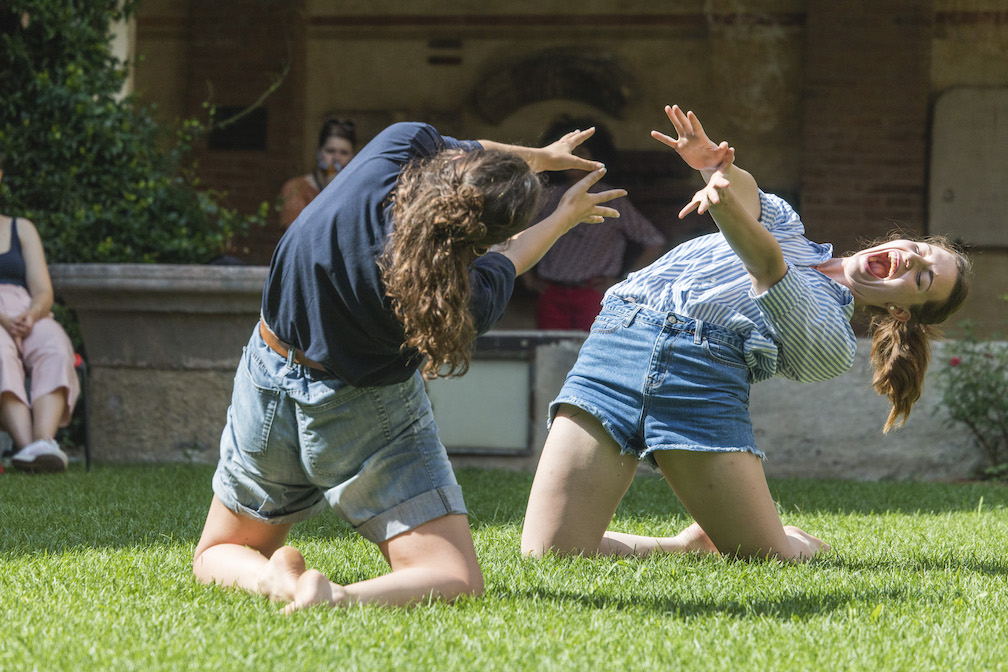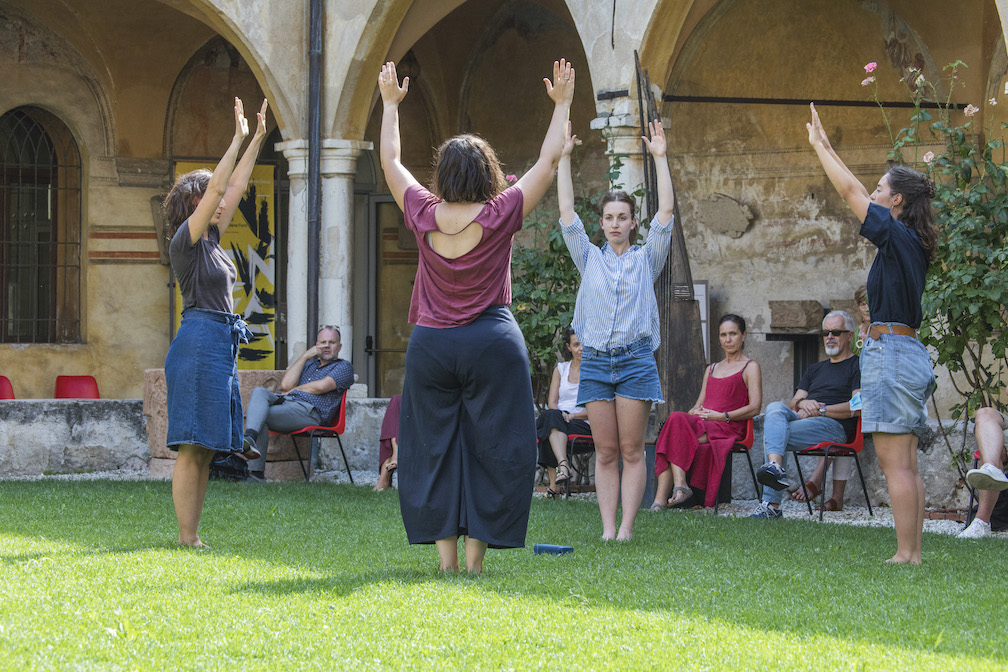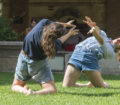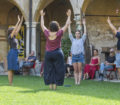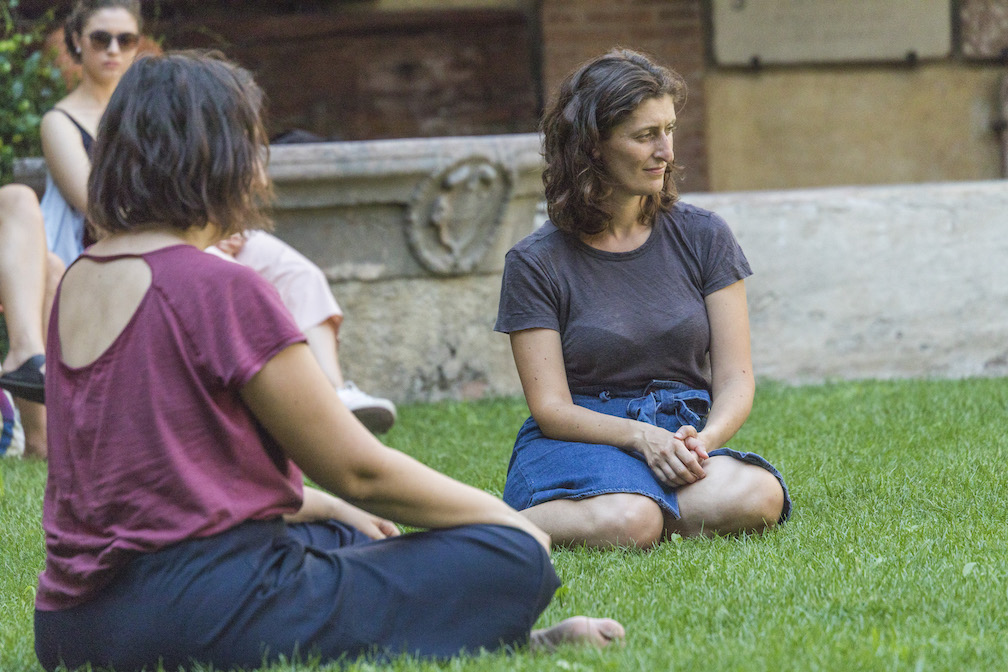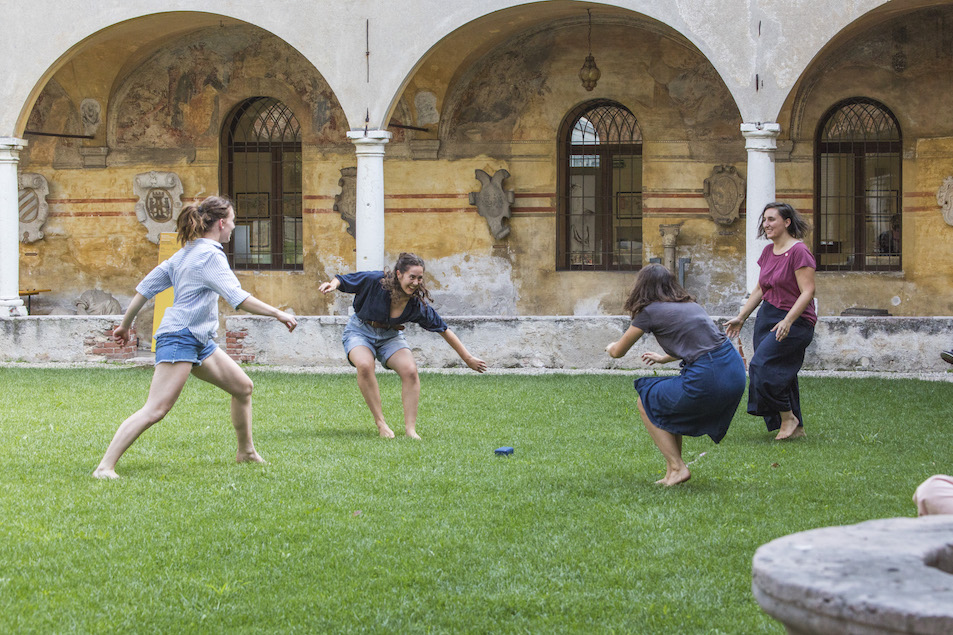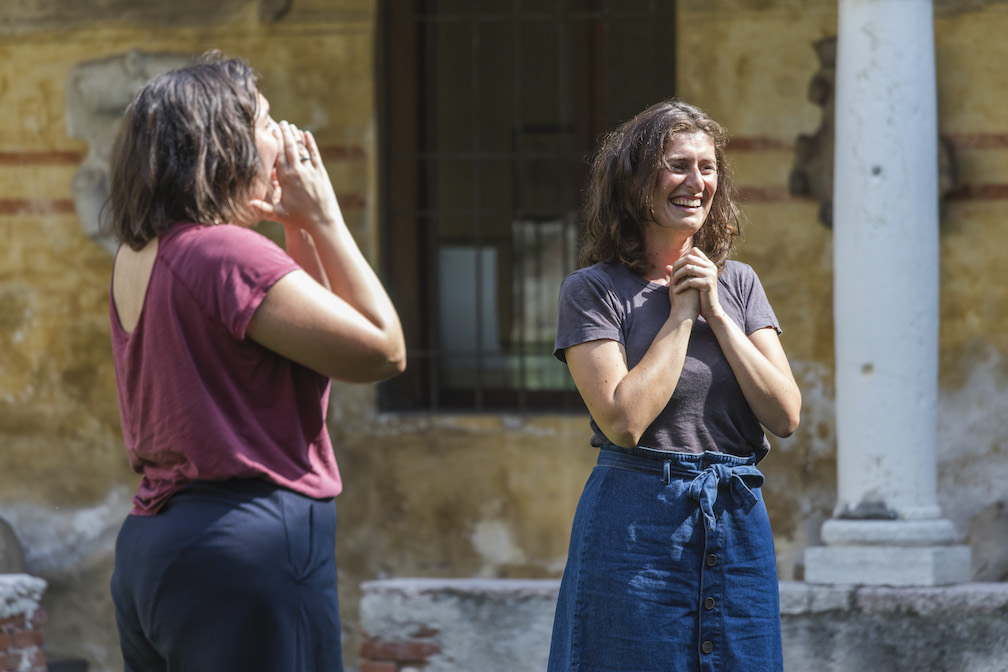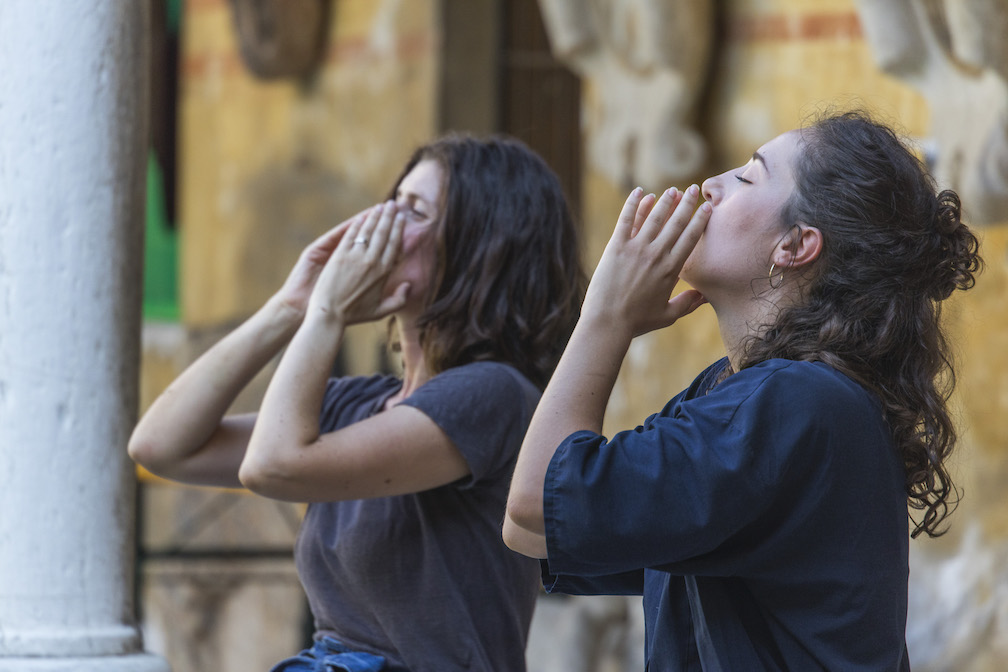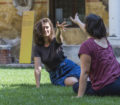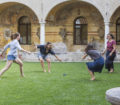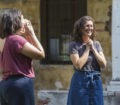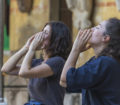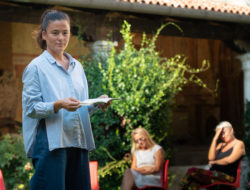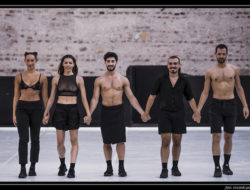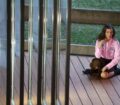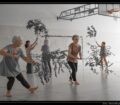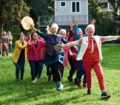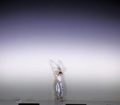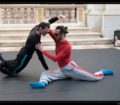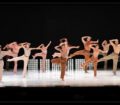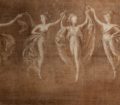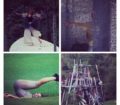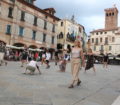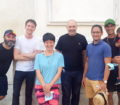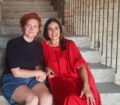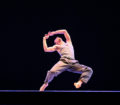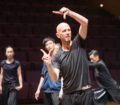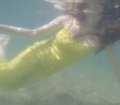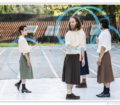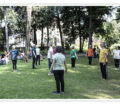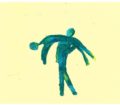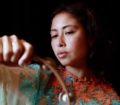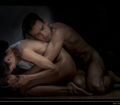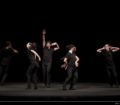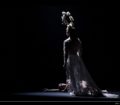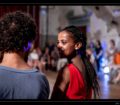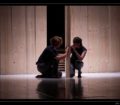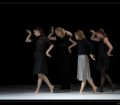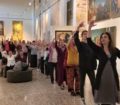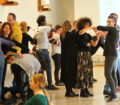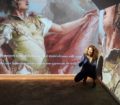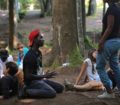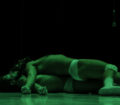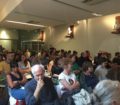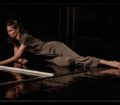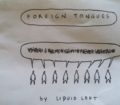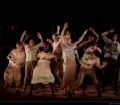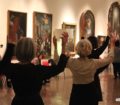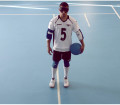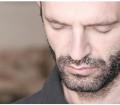ENGLISH TEXT FOLLOWS BELOW
Sii dolce con me. Sii gentile.
È breve il tempo che resta. Poi
saremo scie luminosissime.
E quanta nostalgia avremo
dell’umano.Come ora
ne abbiamo dell’infinità.
Ma non avremo le mani. Non potremo
fare carezze con le mani.
E nemmeno guance da sfiorare
leggere.
Una nostalgia d’imperfetto
ci gonfierà i fotoni lucenti.
Mariangela Gualtieri
ITA |Si dice che non si è in grado di relazionarsi veramente con un’altra persona finché non ci si mette nei suoi panni. In inglese si usa l’espressione: “put yourself in somebody else’s shoes” letteralmente “metti te stesso nelle scarpe altrui”. Questa capacità emotiva e sociale, umana e arcaica, che ci permette di entrare in connessione con gli altri, e comprenderne pensieri, emozioni e stati d’animo come se fosse un nostro vissuto, si chiama empatia. Martin Hoffman la definisce “la scintilla che fa scaturire l’interesse umano per gli altri, il collante che rende possibile la vita sociale”. La scoperta dei neuroni a specchio è stata rivelatrice del ruolo centrale giocato dall’empatia nei processi fisiologici e sociali, con un enorme significato per il ruolo della cultura e dell’arte come espressione fondamentale di questa capacità. La danza esprime quest’attitudine già nella sua pratica più elementare di ascolto del proprio corpo, di connessione tra corpo e spazio, tra corpo e corpo.
Practicing Empathy duets è un lavoro che muove le fila da una duplice ricerca che Yasmeen Godder sta portando avanti da qualche anno. Quella sull’inclusione dello spettatore nel processo artistico, e la condivisione dello spazio scenico tra danzatore e spettatore. E quella sul concetto di empatia, di cui la coreografa israeliana ha piantato i primi semi proprio a Bassano, durante Bmotion Danza 2016, con un imprevedibile Stabat Mater, indimenticabile elegia del sentire e del condividere (di cui potete leggere i nostri approfondimenti qui e qui).
Il titolo è rivelatore della dinamica connessa a questo lavoro: praticare, mettere in atto, esercitare empatia. Un’idea che sembra portare il peso del paradosso in un periodo come questo di grande ottundimento emotivo, nel tempo dell’uomo senza tenerezza, che si deve difendere anche da una stretta di mano, e che sembra dar ragione allo psicologo Paul Bloom quando sostiene che l’empatia non serve a nulla, perché l’uomo, animale abitudinario, è ormai indifferente a chi ha di fronte.
Questo lavoro arriva quindi come una sorta di resilienza emotiva, in cui il corpo è nuovamente la matrice di una nuova confidenza, di una nuova vicinanza.
D’altra parte ce lo siamo chiesti in tanti: come cambierà il nostro modo di relazionarci dopo tutto questo? Come condivideremo di nuovo uno spazio comune, senza più divisori? Riusciremo ad annullare quel distanziamento fisico e sociale a cui pian piano ci stiamo abituando?
La pratica che Yasmeen Godder ha trasmesso a distanza, via Zoom, a Vittoria Caneva, Anna Grigiante, Ilaria Marcolin e Elena Sgarbossa – le danzatrici che si sono avvicendate nei duetti – recupera la profonda leggerezza di un gioco spensierato, di una piccola danza del sentire, a cui si giocava anche da bambini, quando uno di fronte all’altro ci si muoveva in sincrono, senza perdere il contatto reciproco. Come allora valgono poche regole: guardarsi negli occhi, e seguire il movimento dell’altro. Come quello delle mani che si aprono verso il cielo, che disegnano sul proprio volto la grammatica di una simbologia lontana, che si allungano poi verso l’altro, come un desiderio inespresso, e si avvicinano nuovamente alla bocca come a volersi chiamare per nome; e ancora il movimento, ora veloce e ora lento, delle gambe che si spostano lungo il perimetro del rettangolo disegnato a terra, e lo infrangono improvvisamente come si possono infrangere pregiudizi e convinzioni.
In questa “piccola rivoluzione del potere gentile” non importa chi segue chi, non importa chi guida chi. L’elemento infantile della mera imitazione viene meno, mentre rimane la freschezza di un’oasi gioiosa, in cui ogni gesto consegna ancora all’altro qualcosa di se stessi.
La performance è costruita su livelli diversi di trasmissione, osservazione e connessione, che mettono in evidenza la complessità di una dinamica che di primo acchito può sembrare molto semplice.
Il duetto iniziale fiorisce in quartetto con il coinvolgimento di due persone scelte tra il pubblico che si prestano allo stesso tempo a r-accogliere la pratica, ad esserne in parte gli artefici, e infine i testimoni. La dinamica infatti scivola senza interruzione da due a quattro, a due. Seduti alle loro spalle resta il pubblico, coro di testimoni in presenza; e ancora più in là, come un’eco che raggiunge un’indecifrabile distanza, ci sono coloro che assistono alla performance attraverso uno schermo, lo stanza virtuale di Zoom. In questo interscambio, che alterna vicinanza e lontananza, il livello di osservazione rimane orizzontale: tutto avviene allo stesso tempo; la trasmissione tra corpo e corpo è lineare: dalla coreografa alle danzatrici, dalle danzatrici agli attori/spettatori coinvolti. Il livello di connessione invece è a corrente alternata, cambia continuamente direzione a seconda delle emozioni che ogni attore coinvolto mette in gioco: imbarazzo, disorientamento, paura, attenzione, fiducia, curiosità, divertimento.
Ognuno è testimone delle emozioni che corrono lungo quella linea sottile di demarcazione disegnata a terra, degli imbarazzi, delle distrazioni, delle difficoltà di entrare in sintonia con chi ti sta di fronte. Interattività e interconnettività sono quindi le colonne portanti di un’architettura di movimenti che forse non ha nulla di straordinario, ma che in modo eccezionalmente ordinario scioglie quella opaca pesantezza fatta di timori, di sospetto, di diffidenza che la pandemia ha disegnato. Tra i momenti significativi di questa pratica c’è quello in cui uno degli spettatori coinvolti ha improvvisamente rotto le regole del gioco spezzando la distanza fisica, per arrivare a toccare con il proprio dito quello della danzatrice che gli stava davanti. Una tenera voglia di contatto, che ci ricorda come in fin dei conti la nostra intelligenza emotiva non riesca ad accontentarsi di una relazione a metà.
Rita Borga
foto di Giovanni Alfieri /Fotografi Pigri Project
Leggi anche :“Practicing empathy among role shifting | interview with Yasmeen Godder”
ENG| It is said that you are not able to truly relate to another person until “you put yourself in somebody else’s shoes”. This emotional and social skill, both human and archaic, which allows us to connect with others, and understand their thoughts, feelings and moods as if this were our own experience, is called empathy. Martin Hoffman calls it “the spark that triggers human interest towards others, the glue, the bonding that makes social life possible. The discovery of mirror neurons has been revealing of the central role played by empathy in physiological and social processes, with enormous significance for the role of culture and art as a fundamental expression of this ability. Dance expresses this attitude already in its most basic practice of listening to one’s own body, of connecting body to space, and body to body.
Practicing Empathy duets is a work that moves the ranks from a double research that Yasmeen Godder has been carrying on for some years now. The one that includes the spectator in the artistic process, and the sharing of the scenic space between dancer and spectator. Also the one based on the concept of empathy, of which the Israeli choreographer planted the first “seeds” in Bassano, during Bmotion Danza 2016, with an unpredictable Stabat Mater, unforgettable elegy of feeling and sharing (of which you can read our insights here and here).
The title reveals the dynamics connected to this work: practice, implement, exercise empathy. An idea that seems to carry the weight of a paradox in this period, a one of great emotional dullness, in the time of man with no tenderness, defending himself even from a handshake, and that seems to give a good reason to the psychologist Paul Bloom when he claims that empathy is useless, because man, a routine-blinded animal, is now indifferent to whoever stands in front of him.
This work therefore comes as a sort of emotional resilience, in which the body is again the matrix of a new confidence, of a new closeness.
On the other hand, many of us have asked ourselves: how will our way of relating to each other change after all this ? How will we share a common space again, without any more dividers? Will we be able to erase that physical and social distance that we are slowly getting used to?
The practice that Yasmeen Godder transmitted at a distance, via Zoom, to Vittoria Caneva, Anna Grigiante, Ilaria Marcolin and Elena Sgarbossa – the dancers who took turns in the duets – regains the deep lightness of a carefree game, of a tiny dance of emotions, which we played even as children, moving in sync in front of each other, without losing contact with each other. As then a few rules are still valid: looking into each other’s eyes and following each other’s movements. Like the one of hands opening like a flower towards the sky, drawing on each face the grammar of a distant symbology, hands that then stretch out towards each other, like an unspoken desire, and come close again to the mouth as if wanting to call oneself by name; and again the movement of the legs, at once fast and at once slow, that move along the perimeter of the rectangle drawn on the ground, and suddenly break it as one can break prejudices and convictions.
In this “little revolution of gentle power” no matter who follows who, no matter who leads who. The childish element of mere imitation is lost, while the freshness of a joyful oasis remains, in which each gesture still gives the other something of his own self.
The performance is built on different levels of transmission, observation and connection, which, at first glance, highlight the complexity of a very simple dynamic.
The initial duet flourishes in a quartet with the involvement of two people chosen from the audience who lend themselves at the same time to accept the practice, to be partly the creators, and finally the witnesses. The dynamic in fact slides without interruption from two to four, to two.
The audience, a chorus of witnesses in presence, sits behind them; and even further away, like an echo that reaches an indecipherable distance, are those who watch the performance through a screen, the virtual room of Zoom. In this interchange, which alternates proximity and distance, the level of observation remains horizontal: everything happens at the same time; the transmission between body and body is linear: from the choreographer to the dancers, from the dancers to the actors/spectators involved.
The level of connection, on the other hand, is like in “AC” alternating current mode, constantly changing direction according to the emotions that each actor involved brings into play: embarrassment, disorientation, fear, attention, trust, curiosity, fun.
Everyone witnesses the emotions that run along that thin demarcation line drawn on the ground, the embarrassments, the distractions, the difficulties of tuning in with those in front of you. Interactivity and interconnectivity are therefore the pillars of an architecture of movements that perhaps isn’t so extraordinary, but that in an exceptionally ordinary way dissolves that opaque heaviness made of fear, suspicion, distrust that the pandemic has drawn. Among the significant moments of this practice there is the one in which one of the spectators involved suddenly brakes the rules of the game by breaking the physical distance, to get to touch with his finger that of the dancer in front of him. A tender desire for contact, which reminds us that, in the end, our emotional intelligence is not able to be satisfied with a relationship “at half”.
Rita Borga
English translation by Lisa Prada
Photo by Giovanni Alfieri /Fotografi Pigri Project
Yuo can also read: “Practicing empathy among role shifting | interview with Yasmeen Godder”
PRACTICING EMPATHY 2by2
prima nazionale – coproduzione del festival
coreografia
Yasmeen Godder
con
Vittoria Caneva Anna Grigiante Ilaria Marcolin Elena Sgarbossa
assistente alla coreografia
Giovanna Garzotto
coproduzione
Operaestate Festival Veneto
Tags: #bmotiondanza2020, #equalitydance, #operaestate2020, #operaestate40, #yasmeengodder #empathy, recensione

